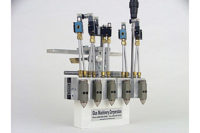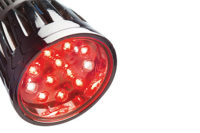
Hot melts are physically hardening adhesives that are applied in their final chemical state. Only polymers that can be liquefied can be used for this type of adhesive - namely meltable thermoplastics, soluble thermoplastics or elastomers, or polymer dispersions. Although poorly crosslinked elastomers with good swelling properties are, strictly speaking, insoluble, they can still be used in certain cases to produce adhesives if they swell enough for the substrates to be wetted. Physically hardening adhesives generally have good bond flexibility, and are used in a variety of applications.
Hot-melt adhesives are, in general, 100%-solid formulations based on thermoplastic polymers. They are solid at room temperature and activated upon heating above their softening point, at which stage they are liquid and can be processed. After application, they retain the ability to wet the substrate until they solidify. Upon solidification, they return to a physical state that has structural integrity and can function as an adhesive.
Hot melts are applied by extruding, rolling or spraying, and joining is carried out immediately after application or after reheating the solidified layer. The high viscosity of the melt makes them particularly suitable for porous and permeable substrates that otherwise would be more difficult to bond with a solvent system.
A feature of hot melts is that, upon cooling, they very rapidly build up their internal strength, allowing rapid assembly and further processing. Because they are based on thermoplastic polymers, hot melts can be repeatedly heated to melt and cooled to solidify. This property limits hot-melt bonds’ temperature resistance; they also have a tendency to creep when subjected to continuous stress or elevated temperatures. However, these adhesives can be used to create bonded joints that are thermally detachable and that can also be re-attached.
Hot melts are used in several industries for a range of applications:
- The packaging industry, for manufacturing of packaging from paper, cardboard and corrugated board.
- The printing industry, for bonding the spines of books.
- The textile industry, for bonding appliqué.
- The shoemaking industry, for bonding (such as bonding shoe soles).
- The wood-processing industry, for veneer surrounds and edging.
- The automotive industry, for applications including bonding insulating and cushioning materials, bonding headlight covers into metal frames, and for wheel covers.
- The electronics industry, for bonding, such as coil windings and coil ends.
Hot-Melt Rods
Hot-melt stick adhesives and hot-melt glue guns are commonly used for craft projects. For industrial use, glue guns are available with higher melt rates and improved durability, and the adhesive is supplied in larger sticks. The adhesive is melted and applied as the stick is advanced into the back of the applicator melt chamber. Hand-held hot-melt applicators are ideal for multi-station assembly or intermittent use, as they require low initial investment and low maintenance.For smaller applications, only low-melt rates and volumes of adhesive are needed, and applicators that use hand pressure to deliver the adhesive can be used. For larger applications, larger applicators using pneumatic systems to deliver adhesive are used. The adhesive is typically applied in beads, which hold heat long enough to allow components to be assembled. Special tips are available to apply single or multiple adhesive beads. These are particularly useful for sealing corrugated cartons, where the tip is also used to guide the application of adhesive along the flap of the carton.
Because the adhesive application and components assembly are done by hand, formulations for use in glue guns need to have longer open time (set more slowly on cooling) than hot melts used in automatic equipment. This allows more time for the adhesive to be applied and parts assembled. Some hot-melt stick adhesives have been developed with extended open time to allow them to be spray-applied for bonding larger areas. A limited amount of pressure is available for dispensing adhesive when glue guns are used, limiting the adhesive melt viscosity for these applicators. In addition, hand application and assembly allows workers to come in contact with the hot applicator tip or molten adhesive. Traditional hot melts are applied at 350-425°F (175-220°C). Proper procedures and safety equipment should be used to avoid burns. To address this concern, a line of hot melts has been developed that allows application at temperatures as low as 250°F (125°C). Although burns can still occur if skin comes in contact with molten adhesive, the lower temperature generally results only in reddening or a minor burn. Performance of these lower-application-temperature adhesives is similar to many higher-application-temperature adhesives but is not as good as the highest performing hot melts. However, they are adequate for many industrial applications.
Bulk Hot Melt
Bulk hot melts are supplied in a variety of shapes, including blocks, pellets, granules, and powders. They are packaged in 1-50 lb bags, and in pails, drums, and totes. A range of applicators is available, depending on the volume output of adhesive needed for the assembly process. Some hot-melt applicators consist of a heated reservoir where solid adhesive is added. Molten adhesive in this reservoir is pumped through heated hoses to either hand-held applicators or automatic applicator heads. Other applicators have a heated grid on which the solid adhesive is placed. The adhesive melts and flows through the grid into a small reservoir that holds a pump. For adhesives supplied as solid blocks in pails or drums, heated platens are available that melt the top layer of adhesive that comes in contact with the platen. An inlet in the center of the platen allows molten adhesive to flow into a pump. Hand-held applicators at the end of the heated hose are used to dispense adhesive in bead or spray form. Automatic applicator heads can be used to dispense beads or ribbons in a variety of patterns or spray the adhesive for bonding large areas. Bulk hot-melt adhesives can also be applied using a roll coater with heated rolls.Bulk hot melts are formulated to match the needs of the application and assembly processes, as well as the performance requirements of the bonded assembly. High-speed, automatic assembly often requires lower viscosity and faster rate of strength buildup. Very large area bonding requires much longer open time (slower setting of the adhesive on cooling to allow wetting of the substrates).
Hot-Melt Film
Hot-melt film adhesives are typically formulated from synthetic polymers. They are available in a variety of thicknesses as either a random web or continuous film. Random-web adhesives provide softer bond lines and drape more easily to conform to three-dimensional shapes, and are often used to laminate or seam fabrics. Continuous-film adhesives are supplied in various widths; wide widths, for example, are used to laminate wide areas such as decorative veneer on composite wood core. Film adhesives can be supplied on release liner and die cut for precise, automated assembly such as in the electronics market. Typically, two substrates or components are joined with the hot-melt film between them and the assembly is heated to liquefy the adhesive. The bond is formed when the adhesive cools and solidifies.Adhesives.org is an online educational portal providing unbiased information about adhesives and sealants to individuals relatively unfamiliar with the technology. Developed by The Adhesive and Sealant Council, Inc. (ASC), the website has been designed to help improve awareness about the benefits and value of the industry’s products, and to help clear up misconceptions.
Source: www.adhesives.org.

